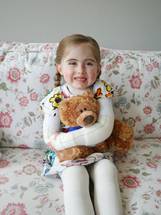FDA Approves First Topical Gene Therapy for Treatment of Wounds in Patients with DEB

Krystal Biotech, Inc.'s Vyjuvek is a genetically modified herpes-simplex virus used to deliver normal copies of the COL7A1 gene to the wounds.
The U.S. Food and Drug Administration approved Vyjuvek, a herpes-simplex virus type 1 (HSV-1) vector-based gene therapy, for the treatment of wounds in patients 6 months of age and older with dystrophic epidermolysis bullosa (DEB) with mutation(s) in the collagen type VII alpha 1 chain (COL7A1) gene.
This application received Orphan Drug and Fast Track designations. Vyjuvek also received Regenerative Medicine Advanced Therapy and Priority Review designations and a Rare Pediatric Disease Priority Review Voucher. The approval of Vyjuvek was granted to Krystal Biotech, Inc.
“Vyjuvek is the first FDA-approved gene therapy treatment for DEB, a rare and serious genetic skin disorder,” says Peter Marks, M.D., Ph.D., director of the FDA’s Center for Biologics Evaluation and Research, in a news release. “Today’s action demonstrates the FDA’s ongoing commitment to supporting the development and evaluation of new treatments that address unmet needs for rare diseases or conditions.”
DEB is a genetic disorder that affects the connective tissue in the skin and nails and results from mutation(s) in the COL7A1 gene. This gene encodes type VII collagen (COL7), which is an essential protein that helps strengthen and stabilize the outer and middle layers of the skin. When COL7A1 is deficient, skin layers can separate, causing painful and debilitating blisters and wounds. DEB usually presents itself at birth and is divided into two major types depending on the inheritance pattern: recessive dystrophic epidermolysis bullosa (RDEB) and dominant dystrophic epidermolysis bullosa (DDEB).
Symptoms can vary widely among affected people. Individuals with DDEB typically have mild cases with blistering primarily affecting the hands, feet, knees, and elbows. RDEB cases can be painful and debilitating, often involving widespread blistering that can lead to vision loss, disfigurement, and other serious medical complications, which could be fatal.
What is Vyjuvek?
Vyjuvek is a genetically modified herpes-simplex virus used to deliver normal copies of the COL7A1 gene to the wounds. COL7 molecules arrange themselves into long, thin bundles that form anchoring fibrils that hold the epidermis and dermis together, which is essential for maintaining the integrity of the skin. Vyjuvek has also been modified to eliminate its ability to replicate in normal cells. Vyjuvek is mixed into an excipient gel prior to topical application. A healthcare professional evenly applies Vyjuvek gel in droplets to a patient’s wounds once a week.
The safety and effectiveness of Vyjuvek was established primarily in a randomized, double-blinded, placebo-controlled study involving a total of 31 subjects with DEB, including 30 subjects with RDEB and one subject with DDEB. In the study, two DEB wounds of comparable size on each patient were identified and randomized to receive either topical administration of Vyjuvek or the placebo on a weekly basis. The age of the subjects ranged from 1 year to 44 years (mean age 17 years). Efficacy was established by improved wound healing, defined as the difference in the proportion of confirmed complete (100%) wound closure between the Vyjuvek-treated and the placebo-treated wounds at 24 weeks. Sixty-five percent of the Vyjuvek-treated wounds completely closed while only 26% of the placebo-treated wound completely closed.
In addition, in a different clinical study, two young patients with RDEB (6 and 7 months of age, respectively) received topical Vyjuvek weekly without any new safety findings.
The most common adverse reactions associated with Vyjuvek included itching, chills, redness, rash, cough and runny nose.
Patients or caregivers should take the following precautions during treatment with Vyjuvek:
- Avoid direct contact with treated wounds (e.g., touching and scratching) and dressings of treated wounds for approximately 24 hours following Vyjuvek application. In the event of accidental exposure, patients and exposed individuals should clean the affected area.
- Wash hands and wear protective gloves when changing wound dressings.
- Disinfect bandages from the first dressing change following Vyjuvek treatment with a virucidal agent, such as 70% isopropyl alcohol, 6% hydrogen peroxide, or <0.4% ammonium chloride, and dispose of the disinfected bandages in a separate sealed plastic bag in household waste. Dispose of the subsequent used dressings and cleaning materials into a sealed plastic bag and dispose in household waste.
This approval is a milestone for the EB community.
"My family has been dreaming of this day since our daughter Elodie was born almost 7 years ago. This is a remarkable milestone for families across the world, who now have a tool to treat their loved ones' pain. We believe this approval will also help pave the way for a cure, which remains elusive. We want to express our unending gratitude to the families, doctors and researchers who worked tirelessly to make this day possible, before we had even heard of EB,” says Emily Kubik, a parent to 6-year-old Elodie Kubik who was born with Recessive Dystrophic Epidermolysis Bullosa (RDEB) and an EB Research Partnership (EBRP) Board Member, in a news release.
EBRP invested in Krystal Biotech in 2017, shortly after Krystal Biotech’s initial public offering of common stock.
"The FDA approval of Krystal Biotech’s VYJUVEK marks a historic day for the EB community. We are grateful for Krystal Biotech’s commitment to delivering the first ever FDA approved treatment for DEB. Our investment in Krystal Biotech provides a strong case for our leading Venture Philanthropy model in action. Having worked in service to the patient community for 20 years, these are the wins that we relentlessly fight for everyday. And tomorrow, we will get up and continue fighting until there is a treatment for every patient and we achieve our ultimate goal of a cure,” says Michael Hund, CEO of EBRP.
PHOTO CREDIT: EBRP

Facebook Comments